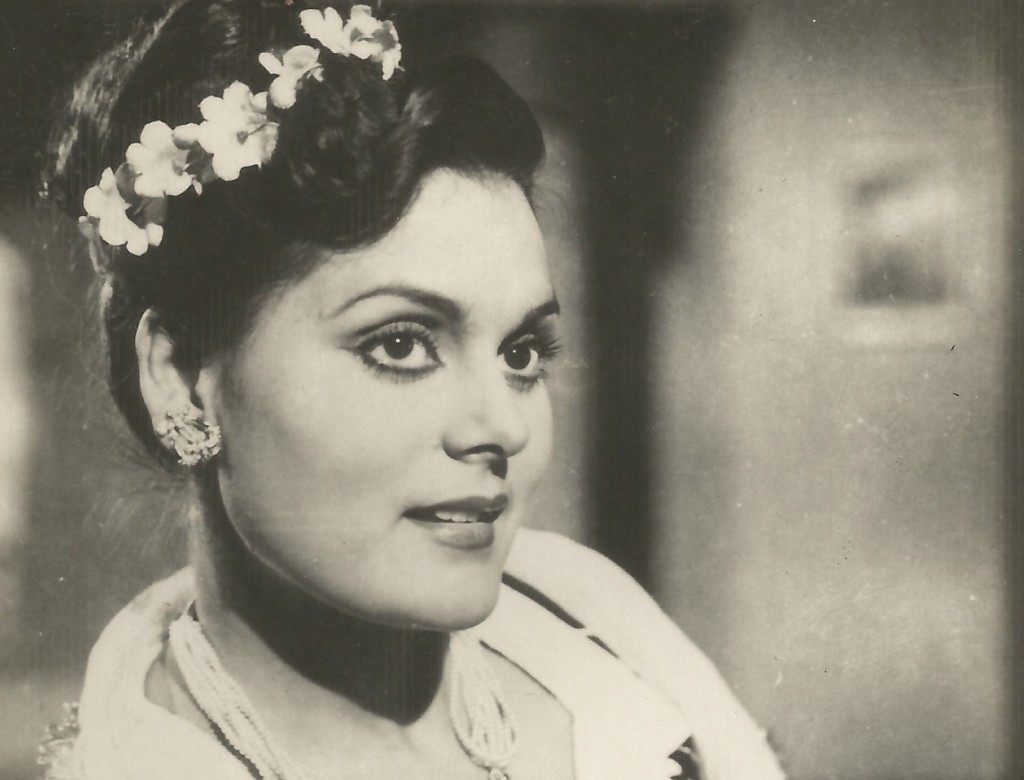Way before Shashikala and Nadira, Kuldip Kaur made a name for herself playing the bad girl to perfection. She will always be remembered for her ‘vamping’ acts in Kaneez (1949), Afsana (1951), Baiju Bawra (1952) and perhaps her most famous film, Anarkali (1953).
Born in 1927 (?), Kuldip, or ‘KK’ as she was known, came from a rich Sikh family of Attari in Punjab. Sadly for her, her father died when she was two, with the property passing on to her uncle. As a youngster, she was quite the tomboy even playing the male lead in her school dramatics. However, she was married off when she was 14 and found herself a mother by the time she was 16. Kuldip was trying for a breakthrough in films in Lahore when the partition of India took place. Said to be involved with actor Pran at the time even though he too was married, the two of them left Lahore together and came to Bombay. They left Lahore in such a hurry that Pran’s car was left behind. Kuldip went back to Lahore even as rioting was in full swing, picked up the car and drove it all the way to Bombay!
While looking for work in Bombay, Kuldip landed up at Bombay Talkies where Savak Vacha took a look at her and requested their German cinematographer Josef Wirsching to take her screen test. Her screen test suggested that her pert nose and highly expressive face would be ideal for casting her as the ‘other woman.’ She was cast in a supporting role in the Dev Anand-Kamini Kaushal starrer, Ziddi (1948), produced by Bombay Talkies. She also appeared in the first ever Punjabi film in post-Independent India, Chaman (1948), and Grahasti that year, playing a modern sophisticated woman and co-starring with Sulochana Chatterjee and Masood. However, Kuldip broke through and scored heavily as the other woman opposite Munawar Sultana’s suffering wife in Kaneez (1949). She played a sexy urban socialite called Darling (!) who causes problems in Munawar Sultana’s marriage to Shyam thereby forcing Sultana to live as a servant in her own house.
With films like Samadhi (1950) and Afsana (1951), Kuldip became the top vamp in Hindi films. Samadhi, a patriotic drama, addressing Subash Chandra Bose and the Indian National Army saw her as part of a British spy ring as the dancer Dolly. In one of her most enduring images, Kuldip, in pants, tailcoat and all, dances with Nalini Jaywant in the all time hit Gore Gore O Banke Chhore. Afsana saw her cast typically as Ashok Kumar’s adultrous wife having an affair with his friend, played by Pran. With her colorful role, Kuldip easily stole a march over the bland goody-two-shoes heroine, Veena. Be it the flirtatious coquette or pretending to be the grieving widow, Kuldip was spot on making Afsana one of her most memorable films.
Other films in which Kuldip made a major impact include Mukhda (1951), where she played a rare leading role, Baiju Bawra where she played a strong dacoit queen who takes Baiju away with her and Anarkali as Bina Rai’s rival doing her best to thwart the legendary Salim – Anarkali romance.
Baaz (1953) saw her playing a Portuguese woman (!) trying to seduce an Indian prince played by Guru Dutt. She keeps pouting “Huzoor” at him only to be met with his classic rebuff – “Zara Door.” She has her moments in the film and the sexiest song of the film – Taare Chandni Afsane, rendered brilliantly by Geeta Dutt in her unique manner, picturized on her as she plays up to Dutt. She also played prominent roles in the Punjabi films Chhai (1950) and Madari (1950) besides producing and acting in the Geeta Bali – Shammi Kapoor starrer, Miss Coca Cola (1955).
Kuldip continued to do films steadily post Anarkali but none of her subsequent roles really had the sort of impact of Afsana or Anarkali except maybe for Ek Saal (1957), where she played Ashok Kumar’s partner in crime, who loses him to Madhubala. She is in fine form doing all she can to destroy their love story as she has her eyes on Ashok Kumar, herself.
Outside of her film career, Kuldip also courted controversy when she was charged with spying for Pakistan a few years after Independence. She was also implicated and framed in a counterfeiting case.
Kuldip died due to lockjaw (Tetanus) resulting from a trip to Shirdi in 1960. She had walked amidst some fields to eat ‘ber’ and found her leg infested with thorns of the plant. Though she laughingly pulled them out, a couple of thorns stayed in. Not taking it seriously, she went back to Bombay and resumed shooting but she soon developed fever and an infection which spread rapidly. Some of her films like the Punjabi movie, Yamla Jatt (1960) released after her death.



Good description.